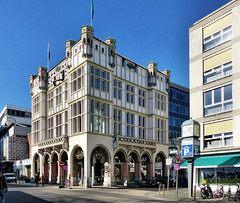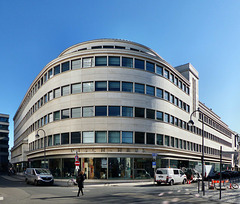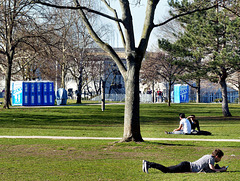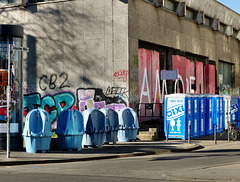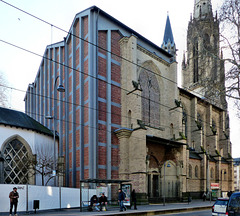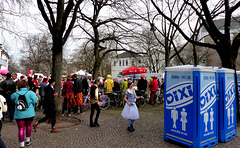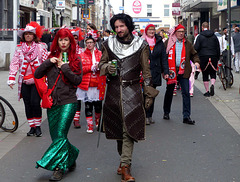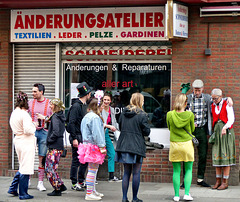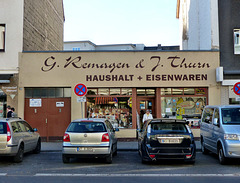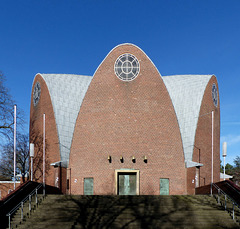Martin M. Miles' photos
Cologne - 4711
| |
|
|
4711 is a German Eau de Cologne, that because it has been produced in Cologne since at least 1799, it is allowed to use the geographical indication Original Eau de Cologne.
According to legend Carl Gereon Farina, a Carthusian monk with Italian roots, made the secret recipe of a remedy named "aqua mirabilis" a wedding gift for Wilhelm Mülhens. Mühlens then started a small factory at Cologne's "Glockengasse to produce the remedy.
After French troops had occupied Cologne in 1794 the guard-committee received authorisation to number all houses in Cologne . It is believed that the house in which the "Eau de Cologne" was produced got the number "4711".
When Peter Joseph Mülhens moved from Glockengasse 12 into a newly constructed commercial building with a neo-gothic facade at Glockengasse 26-28, who then brought the number "4711" to the new building.
The building was completely destroyed by an air raid in 1943. In 1963 a new building in the style of the pre-war building was built at Glockengasse 4.
The Mühlens family sold the business to Wella AG in 1994. Wella AG was taken over by Procter & Gamble in 2003. Procter & Gamble sold the 4711 brand to Mäurer & Wirtz in 2006.
Cologne - Disch-Haus
| |
|
The building has its name from the magnificent "Hotel Disch", a posh hotel, that opened here in 1848, one of the most internationally renowned hotels in Cologne. The hotel changed hands a couple of times, and after the last owner went bancrupt, the city acquired the building that got demolished.
Architects Bruno Paul and Franz Weber won a competition for the construction of a monumental municipal administration building, done in the style of "Neue Sachlichkeit" ("New Objectivity", "Nouvelle Objectivité"). It was opened in 1930 having 7 floors. It lost the two top floors dueing the air raids of WWII, so by now it has only 5 floors.
Cologne - Carnival
| |
|
Carnival has a long tradition not only in Cologne, where it is known and often got suppressed since medieval times. The French did not like it, but allowed carnival in 1804, from then on, carneval societies were founded often making fun of (French and later Prussian) militarism.
The "fifth season" (carnival season) in Cologne is declared open at 11 minutes past 11 on the 11th of the 11th month November. That is the time of balls and sessions. The carneval hits the streets on Fat Thursday (Weiberfastnacht) with a declaration at the Alter Markt square at 11.11h. on the Thursday before the beginning of Lent.
Shops are closed, pubs are open, Cologne folks are masqueraded, drink, sing and dance.
When more than one million people sing, dance and drink "Kölsch" beer, this behaviour surely has certain impacts. These have been calculated - and thousands of portable toilets and urinals are distributed over the city.
Cologne - Carnival
| |
|
Carnival has a long tradition not only in Cologne, where it is known and often got suppressed since medieval times. The French did not like it, but allowed carnival in 1804, from then on, carneval societies were founded often making fun of (French and later Prussian) militarism.
The "fifth season" (carnival season) in Cologne is declared open at 11 minutes past 11 on the 11th of the 11th month November. That is the time of balls and sessions. The carneval hits the streets on Fat Thursday (Weiberfastnacht) with a declaration at the Alter Markt square at 11.11h. on the Thursday before the beginning of Lent.
Shops are closed, pubs are open, Cologne folks are masqueraded, drink, sing and dance.
When more than one million people sing, dance and drink "Kölsch" beer, this behaviour surely has certain impacts. These have been calculated - and thousands of portable toilets and urinals are distributed over the city.
Cologne - Herz Jesu
| |
|
Cologne is the fourth-largest city in Germany - and one of the oldest. A Germanic tribe, the Ubii, had a settlement here, this was named by the Romans "Oppidum Ubiorum". In 50 AD, the Romans founded "Colonia Claudia Ara Agrippinensium", the city then became the provincial capital of "Germania Inferior".
During WWII Cologne was bombed in 262 separate air raids. In April 1945, when the American armee reached Cologne, the city was completely ruined. About 90% of all houses in the inner city were - gone. In 1939 Cologne had had a population of more than 700.00. In spring 1945 there were only about 40.000, living in the ruins. So most of the buildings in Cologne are pretty "young".
The Herz-Jesu church, erected in the center of the "Zülpicher Platz" from 1893 on, got severely damaged during the air raids. So after WWII only the neo-Gothic tower and a part of the choir could got restored between 1953 and 1957, the rest got rebuilt in contemporary architecture.
Cologne - Herz Jesu
| |
|
|
Cologne is the fourth-largest city in Germany - and one of the oldest. A Germanic tribe, the Ubii, had a settlement here, this was named by the Romans "Oppidum Ubiorum". In 50 AD, the Romans founded "Colonia Claudia Ara Agrippinensium", the city then became the provincial capital of "Germania Inferior".
During WWII Cologne was bombed in 262 separate air raids. In April 1945, when the American armee reached Cologne, the city was completely ruined. About 90% of all houses in the inner city were - gone. In 1939 Cologne had had a population of more than 700.00. In spring 1945 there were only about 40.000, living in the ruins. So most of the buildings in Cologne are pretty "young".
The Herz-Jesu church, erected in the center of the "Zülpicher Platz" from 1893 on, got severely damaged during the air raids. So after WWII only the neo-Gothic tower and a part of the choir could got restored between 1953 and 1957. The nave, seen here, got rebuilt in a modern style.
Cologne - Herz Jesu
| |
|
|
Cologne is the fourth-largest city in Germany - and one of the oldest. A Germanic tribe, the Ubii, had a settlement here, this was named by the Romans "Oppidum Ubiorum". In 50 AD, the Romans founded "Colonia Claudia Ara Agrippinensium", the city then became the provincial capital of "Germania Inferior".
During WWII Cologne was bombed in 262 separate air raids. In April 1945, when the American armee reached Cologne, the city was completely ruined. About 90% of all houses in the inner city were - gone. In 1939 Cologne had had a population of more than 700.00. In spring 1945 there were only about 40.000, living in the ruins. So most of the buildings in Cologne are pretty "young".
The Herz-Jesu church, erected in the center of the "Zülpicher Platz" from 1893 on, got severely damaged during the air raids. So after WWII only the neo-Gothic tower and a part of the choir could got restored between 1953 and 1957. The nave got rebuilt in a modern style.
Cologne - Carnival
| |
|
Carnival has a long tradition not only in Cologne, where it is known and often got suppressed since medieval times. The French did not like it, but allowed carnival in 1804, from then on, carneval societies were founded often making fun of (French and later Prussian) militarism.
The "fifth season" (carnival season) is declared open at 11 minutes past 11 on the 11th of the 11th month November. That is the time of balls and sessions. The carneval hits the streets on Fat Thursday (Weiberfastnacht) with a declaration at the Alter Markt square at 11.11h. on the Thursday before the beginning of Lent.
Shops are closed, pubs are open, Cologne folks are masqueraded, bands perform on streets and squares, people sing and dance. For somebody not born here - it feels a bit strange.
Cologne - Carnival
| |
|
|
Carnival has a long tradition not only in Cologne, where it is known and often got suppressed since medieval times. The French did not like it, but allowed carnival in 1804, from then on, carneval societies were founded often making fun of (French and later Prussian) militarism.
The "fifth season" (carnival season) is declared open at 11 minutes past 11 on the 11th of the 11th month November. That is the time of balls and sessions. The carneval hits the streets on Fat Thursday (Weiberfastnacht) with a declaration at the Alter Markt square at 11.11h. on the Thursday before the beginning of Lent.
Shops are closed, pubs are open, Cologne folks are masqueraded, sing and dance. For somebody not born here - it feels a bit strange.
The emperor and his jester return from the bottle shop.
Cologne - Carnival
| |
|
Carnival has a long tradition not only in Cologne, where it is known and often got suppressed since medieval times. The French did not like it, but allowed carnival in 1804, from then on, carneval societies were founded often making fun of (French and later Prussian) militarism.
The "fifth season" (carnival season) is declared open at 11 minutes past 11 on the 11th of the 11th month November. That is the time of balls and sessions. The carneval hits the streets on Fat Thursday (Weiberfastnacht) with a declaration at the Alter Markt square at 11.11h. on the Thursday before the beginning of Lent.
Shops are closed, pubs are open, Cologne folks are masqueraded, sing and dance. For somebody not born here - it feels a bit strange.
Cologne - Carnival
| |
|
Carnival has a long tradition not only in Cologne, where it is known and often got suppressed since medieval times. The French did not like it, but allowed carnival in 1804, from then on, carneval societies were founded often making fun of (French and later Prussian) militarism.
The "fifth season" (carnival season) is declared open at 11 minutes past 11 on the 11th of the 11th month November. That is the time of balls and sessions. The carneval hits the streets on Fat Thursday (Weiberfastnacht) with a declaration at the Alter Markt square at 11.11h. on the Thursday before the beginning of Lent.
Shops are closed, pubs are open, Cologne folks are masqueraded, sing and dance. For somebody not born here - it feels a bit strange.
Folks are not only queueing to enter pubs. They as well stand in line for - toilets.
Cologne - Carnival
| |
|
Carnival has a long tradition not only in Cologne, where it is known and often got suppressed since medieval times. The French did not like it, but allowed carnival in 1804, from then on, carneval societies were founded often making fun of (French and later Prussian) militarism.
The "fifth season" (carnival season) is declared open at 11 minutes past 11 on the 11th of the 11th month November. That is the time of balls and sessions. The carneval hits the streets on Fat Thursday (Weiberfastnacht) with a declaration at the Alter Markt square at 11.11h. on the Thursday before the beginning of Lent.
Shops are closed, pubs are open, Cologne folks are masqueraded, sing and dance. For somebody not born here - it feels a bit strange.
Folks are queueing to enter "Früh im Veedel", a popular pub next to the Severinstor.
Cologne - Carnival
| |
|
Carnival has a long tradition not only in Cologne, where it is known and often got suppressed since medieval times. The French did not like it, but allowed carnival in 1804, from then on, carneval societies were founded often making fun of (French and later Prussian) militarism.
The "fifth season" (carnival season) is declared open at 11 minutes past 11 on the 11th of the 11th month November. That is the time of balls and sessions. The carneval hits the streets on Fat Thursday (Weiberfastnacht) with a declaration at the Alter Markt square at 11.11h. on the Thursday before the beginning of Lent.
Shops are closed, pubs are open, Cologne folks are masqueraded, sing and dance. For somebody not born here - it feels a bit strange.
Cologne - Carnival
| |
|
Carnival has a long tradition not only in Cologne, where it is known and often got suppressed since medieval times. The French did not like it, but allowed carnival in 1804, from then on, carneval societies were founded often making fun of (French and later Prussian) militarism.
The "fifth season" (carnival season) is declared open at 11 minutes past 11 on the 11th of the 11th month November. That is the time of balls and sessions. The carneval hits the streets on Fat Thursday (Weiberfastnacht) with a declaration at the Alter Markt square at 11.11h. on the Thursday before the beginning of Lent.
Shops are closed, pubs are open, Cologne folks are masqueraded, sing and dance. For somebody not born here - it feels a bit strange.
Folks are queueing to enter Filos, a pub in the Südstadt. Note the blue puppet. This is "Nubbel", a strawfilled puppet, that can be found over most pubs. Nubbel is a scapegoat. Nobbel will be blamed for all sins of anybody that may have happened over carnival. Nubbel will be sentenced to death and burned in the night before Ash Wednesday.
Cologne - Cathedral
| |
|
Cologne is the fourth-largest city in Germany - and one of the oldest. A Germanic tribe, the Ubii, had a settlement here, this was named by the Romans "Oppidum Ubiorum". In 50 AD, the Romans founded "Colonia Claudia Ara Agrippinensium", the city then became the provincial capital of "Germania Inferior".
A Roman temple existed here in Roman times, but from th3 4th century on, the site was occupied by Christian buildings.
The foundation stone of the Cologne Cathedral (Kölner Dom) was laid on 15 August 1248. The eastern arm was completed and got consecrated in 1322. In 1473 the works came to a halt, leaving the south tower complete up to the belfry level and crowned with a huge crane for the next 400 years.
After the original plans for the façade had been found in Darmstadt and Paris 1814/1816 it was decided to complete the cathedral. Two thirds of the costs were raised by civic efforts, while the remaining costs were covered by the Prussian state. The state saw this as a way to improve its relations with the large number of Catholic subjects it had gained in 1815, when the Catholic Rhineland was added to the Protestant Prussian Kingdom.
In 1842 Frederick William IV of Prussia and Johannes von Geissel, later archbishop of Cologne, laid the foundation stone for the completion. In 1880, 632 years after construction had begun, the Cologne Cathedral was completed. The celebration was attended by Emperor Wilhelm I.
The design of Cologne Cathedral was based quite closely on that of Amiens Cathedral. As it is a Gothic cathedral, the plan is in the shape of a Latin Cross with two aisles on either side. The window surface area is about 10.000m², About 1.500m² of these are medieval. The oldest is from 1260.
The "Richter-Fenster" named after the artist Gerhard Richter, who created it, is the youngest. In 1863 a window with the depiction of secular and Christian rulers had been installed here, donated by the Kingdom of Prussia. This windows was destroyed in World War II and got replaced by a colourless ornamental window in 1948, that soon needed restauration. In 2006 Gerhard Richter (* 1932) got comissioned by the chapter to created the window seen here.
On a surface of 106m² there are 11.263 glass squares in 72 colours. These square are randomly arranged. This window was very disputed! The archbishop, who is not a member of the chapter, did not like it at all. Most others did - and do. It creates a wonderful light.
A close up.
Cologne - Cathedral
| |
|
|
Cologne is the fourth-largest city in Germany - and one of the oldest. A Germanic tribe, the Ubii, had a settlement here, this was named by the Romans "Oppidum Ubiorum". In 50 AD, the Romans founded "Colonia Claudia Ara Agrippinensium", the city then became the provincial capital of "Germania Inferior".
A Roman temple existed here in Roman times, but from th3 4th century on, the site was occupied by Christian buildings.
The foundation stone of the Cologne Cathedral (Kölner Dom) was laid on 15 August 1248. The eastern arm was completed and got consecrated in 1322. In 1473 the works came to a halt, leaving the south tower complete up to the belfry level and crowned with a huge crane for the next 400 years.
After the original plans for the façade had been found in Darmstadt and Paris 1814/1816 it was decided to complete the cathedral. Two thirds of the costs were raised by civic efforts, while the remaining costs were covered by the Prussian state. The state saw this as a way to improve its relations with the large number of Catholic subjects it had gained in 1815, when the Catholic Rhineland was added to the Protestant Prussian Kingdom.
In 1842 Frederick William IV of Prussia and Johannes von Geissel, later archbishop of Cologne, laid the foundation stone for the completion. In 1880, 632 years after construction had begun, the Cologne Cathedral was completed. The celebration was attended by Emperor Wilhelm I.
The design of Cologne Cathedral was based quite closely on that of Amiens Cathedral. As it is a Gothic cathedral, the plan is in the shape of a Latin Cross with two aisles on either side. The window surface area is about 10.000m², About 1.500m² of these are medieval. The oldest is from 1260.
The "Richter-Fenster" named after the artist Gerhard Richter, who created it, is the youngest. In 1863 a window with the depiction of secular and Christian rulers had been installed here, donated by the Kingdom of Prussia. This windows was destroyed in World War II and got replaced by a colourless ornamental window in 1948, that soon needed restauration. In 2006 Gerhard Richter (* 1932) got comissioned by the chapter to created the window seen here.
On a surface of 106m² there are 11.263 glass squares in 72 colours. These square are randomly arranged. This window was very disputed! The archbishop, who is not a member of the chapter, did not like it at all. Most others did - and do. It creates a wonderful light.
Cologne - Remagen & Thurn
| |
|
Cologne is the fourth-largest city in Germany - and one of the oldest. A Germanic tribe, the Ubii, had a settlement here, this was named by the Romans "Oppidum Ubiorum". In 50 AD, the Romans founded "Colonia Claudia Ara Agrippinensium", the city then became the provincial capital of "Germania Inferior".
So far, I have nearly never noticed old hardware stores, but since I found Edward Bosen´s given up shop in Sülz, I see them everywhere. They all have their traditions. "G. Remagen & J. Thurn" is for sure the leading hardware shop in Rhiel. The gap between the two large houses, that now flank the shop, is probably the result of an air-raid damage.
Cologne - St. Engelbert
| |
|
|
Cologne is the fourth-largest city in Germany - and one of the oldest. A Germanic tribe, the Ubii, had a settlement here, this was named by the Romans "Oppidum Ubiorum". In 50 AD, the Romans founded "Colonia Claudia Ara Agrippinensium", the city then became the provincial capital of "Germania Inferior".
St. Engelbert is a circular church built on a pedestal. The tower is like a campanile separated from the building. The basic form of the church is formed by parabolic, high outer walls, which form a circular shape with segments curved like a shield.
The church, designed by architect Dominikus Böhm, was erected 1931 and got consecrated, though not finally completed, in 1932. This building was only possible using the modern material of reinforced concrete. The shape of the paraboloidal vaulting in a central point and the slender shape of the 40 meter high campanile required a concrete structure backed by reinforced concrete. The outside walls got clad with clinkers.
Unfortunately the church, sometimes dubbed "Zitronenpresse" (lemon squeezer), was locked. What was a real pity!
Jump to top
- ipernity © 2007-2024
- Help & Contact
|
Club news
|
About ipernity
|
History |
ipernity Club & Prices |
Guide of good conduct
Donate | Group guidelines | Privacy policy | Terms of use | Statutes | In memoria -
Facebook
Twitter

